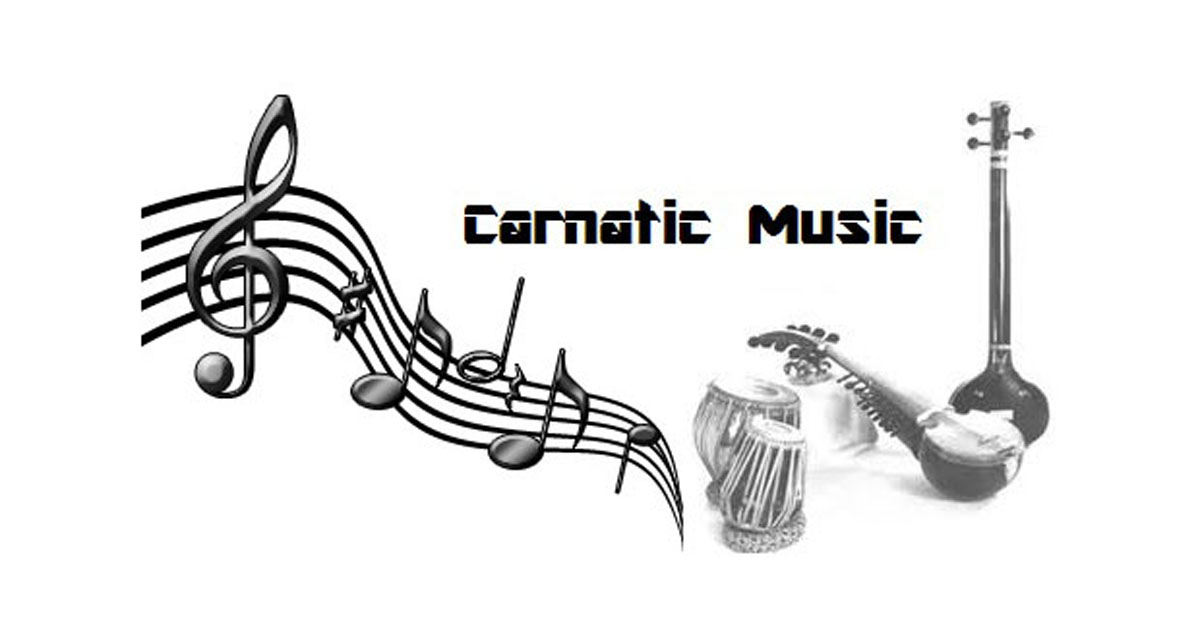Carnatic Music – Ragas From South India

Carnatic music originated in the fertile plains of the Cauvery delta and flourished through the ages. Carnatic Music is believed to have divine origins – Goddess Saraswati, the Hindu Goddess of Learning, is depicted with the veena, a fretted musical instrument.
One of the unique attributes of Indian music is the concept of relative pitch. The singer or instrumentalist who is the main performer is free to choose any note as his or her fundamental (adhaara shadjam). This determines the Sruti or relative pitch. Every other note is defined relative to this fundamental. Unlike Western music in which voices are categorized in groups such as bass, tenor, or soprano, in Carnatic music, every composition can be performed by every musician by choosing a pitch that is appropriate to the natural tone of his or her voice. Most concert performers train their voices to reach 2-3 octaves relative to their fundamentals. The use of tambura or drone is a must as a background accompaniment as it helps the performers sustain their sruti.
Fundamentals of Carnatic music
The most basic unit of music is the swara (or note) which simply indicates the position in the audible spectrum occupied by a particular sound or the pitch of the sound. Actually, the spectral position is better described as swara sthana. Inherently, certain sounds ‘go together‘ and certain others do not. This property was realized by man thousands of years ago and is indicated by the term harmony; lack of harmony is called disharmony.
Carnatic music has two main elements: Raaga (Raagam) and Thaala (Thaalam). Raaga is the mode and Thaalam is the rhythmic cycle. There are numerous raagas and thaalams and with their combination, you can sing different and wonderful songs.
There are seven basic swaras in Indian Classical music. They are Sa, Ri, Ga, Ma, Pa, Da, and Ni. With different combinations of these swaras different ragas were created. The group of the first four swaras of the Saptha Swaras – Sa, Ri, Ga, and Ma – is known as the Purvanga. The group of the last three notes – Pa, Da, and Ni – is known as Uttharanga.
Vocal music is given primary importance in Carnatic music. A reason for this could be the wealth of compositions available. Compositions are rich in lyrics which often include prayers to Hindu Gods, descriptions of temples, and vivid descriptions of stories from epics such as Ramayana. In a typical concert, the main performer is usually a vocalist and he or she is accompanied by a violinist and one or more percussionists. The mridangam is generally the main percussion instrument and often, additional percussion instruments such as ghatam (clay pot), kanjeera (tambourine), and morsing (jew’s harp) are available. Concerts, where the main performer is an instrumentalist such as violinist, veena player, or flutist, are also common and quite popular.
A key attribute of Carnatic music is that each composition is typically designed for performance by one individual although all compositions can certainly perform as a chorus. For this reason, there is less emphasis on harmony (i.e., multiple notes being sounded at the same time) and more emphasis on the flow of the whole piece in one voice. Since Carnatic music and the Hindu religion are inextricably linked, the lyrics have profound spiritual significance.
Musical instruments
The tambura is widely used as a drone instrument to help sustain pitch during a rendition. The veena is one of the ancient Carnatic instruments. It is believed to have evolved into its current form over several thousand years. It is a lute-type instrument with 24 frets. The violin has been adapted into Carnatic music and now occupies a high position due to its ability to produce a continuous tone and gamakams. The flute, chitraveena (gottuvadyam), and nadaswaram are some other traditional instruments. Many Western instruments such as the guitar and saxophone are also increasingly being used to perform Carnatic music. The mridangam is the chief percussion instrument, with the ghatam, kanjeera, and morsing playing a subsidiary role.
Suggested Read: Hindustani Music
